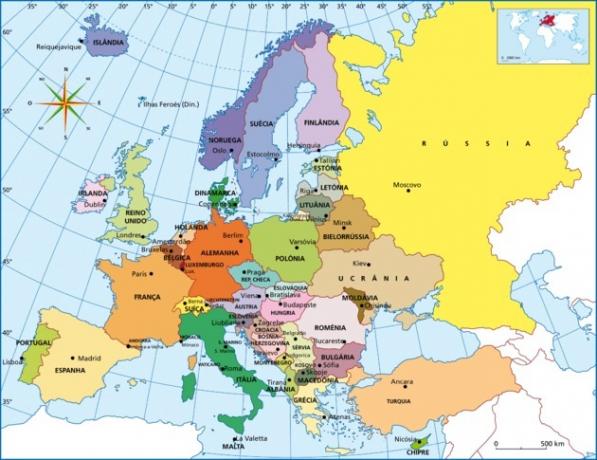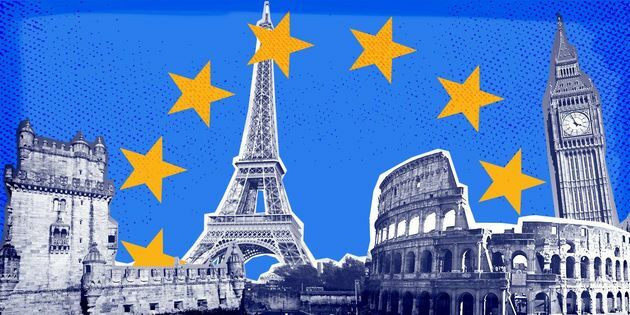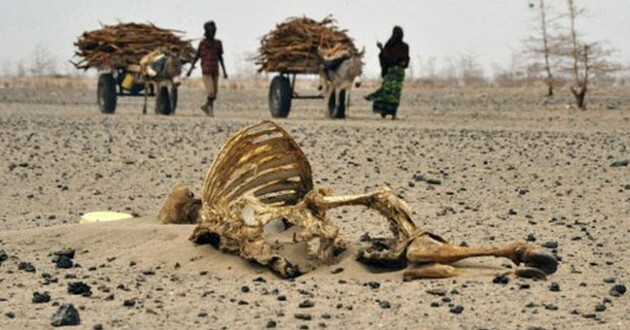THE Europe is a continent that is located in the northern hemisphere of the terrestrial globe. It comprises a total area of 10,498,000 km2 and has a population of 744.7 million inhabitants.
The Russian Federation is the largest country in Europe, with 17,075,400 km2, and the most populous, with 143.5 million inhabitants.
Next comes Germany with 357,120 km2, with a population of 81.89 million inhabitants.
Location of Europe

Europe is limited to the north by the Arctic Glacial Ocean; to the east with the Ural Mountains; to the south with the Mediterranean Sea; and to the west with the Atlantic Ocean.
European countries
Europe is formed by 50 countries. There is great diversity between the sizes of each one and we can find the small Vatican (0.44 km)2), Monaco (0.44 km2), San Marino (61.2 km2), Liechtenstein (160 km2) and the Principality of Andorra (468 km2).
Despite being between two continents, Asia and Europe, the biggest countries in Europe are the Russian Federation, Kazakhstan and Turkey.
The island of Cyprus is part of Asia, but politically it belongs to Europe. The small island is occupied by Turkey and the United Kingdom, which still maintain military bases there. Part of the territory, the south, was admitted to the European Union in 2004.
Georgia, Azerbaijan and Armenia, from a geographical point of view, are countries belonging to the Asian continent. They are located in the Caucasus region, considered transcontinental countries.
Azerbaijan and Georgia border Russia (European part), the former being a member of the Council of Europe since 25 January 2001.
transcontinental countries in europe
- Russia
- Kazakhstan
- Azerbaijan
- Georgia
- Turkey
Search more about the topic:
- Eastern Europe
- Scandinavia
European Union
THE European Union (EU) is an economic and political bloc whose main objective is to maintain peace on the European continent through economic, social and cultural programs.
Of the total, 28 countries participate in the European Union, namely:
- Germany
- Austria
- Belgium
- Bulgaria
- Cyprus
- Croatia
- Denmark
- Slovakia
- Slovenia
- Spain
- Estonia
- Finland
- France
- Greece
- Hungary
- Ireland
- Italy
- Latvia
- Lithuania
- Luxembourg
- Malta
- Netherlands
- Poland
- Portugal
- UK
- Czech Republic
- Romania
- Sweden
As this block has a common currency, the euro, 19 countries established it as their official currency.
Currently, for the first time in the history of this association, one of its members, the United Kingdom, has asked to withdraw from this institution. The process started in 2017 and is known as Brexit.
Understand more about this subject:
- European Union
- Maastricht Treaty
Economy of Europe
Europe's economy is diversified, with a predominance of industry and services.
European industry

Among the most industrialized countries are Germany, the United Kingdom and France.
The continent stands out in the manufacture of automobiles, shoes, luxury industry (cosmetics and clothing). Despite this, the 2008 global crisis raised the European continent's unemployment rate.
France is the first nuclear energy producer in the world, from which it extracts 76% of its electricity needs, in addition to selling part of it to Germany and Belgium.
European agriculture
THE agriculture, in some European countries, it is not enough to meet the needs of the population. In the United Kingdom, agriculture occupies a small part of the territory.
The use of agricultural labor is the lowest in the world and food production meets only 40% of the population's food needs, the rest is imported.
Countries like Spain and Italy are big producers of meat, olive oil and fruit. France, on the other hand, stands out with its wines and dairy products.
Services and Finance in Europe
The service sector is the strongest in Europe. To give you an idea, of the twenty largest companies on this continent, 12 are in the financial sector, such as the British bank HSBC or the German insurance company Allianz.
Tourism is also essential for keeping the accounts balanced. Portugal, for example, receives around 12.76 million visitors in 2018 and this activity already accounts for 13.7% of the country's GDP, according to data from the National Institute of Statistics.
Europe's Climate and Vegetation
Europe's climate and landscapes feature three major natural regions:
- Northern Europe: domain of tundra (underground vegetation, which supports very low temperatures), subpolar plains and mountains (polar climate). Domain of taiga and land where wild and low-lying plants grow; region of less intense cold to the west due to maritime influence (cold climate).
- Oceanic and continental plains Europe: plains region, natural environment altered by the action of man and predominance of agriculture (temperate climate). Mountainous regions dominated by forests and many stretches modified by man and some regions with a semiarid climate.
- southern mountain europe: high mountain cold climate region. Mediterranean region with mountains and places modified by the action of man and regions of Mediterranean plains and plateaus (mediterranean climate).
European culture

European culture is diversified as the sum of various peoples, religions and knowledge that developed in this region.
The first civilization that influenced the continent was the Greek. Despite being a handful of cities that competed with each other, the Greeks left their marks on politics, philosophy, medicine, astronomy, art, etc.
Later, they were dominated by the Romans who copied many of their teachings and expanded their domains to the north, in present-day England. The Romans carried their legal system and customs across the continent.
Likewise, with the advent of Christianity, the European peoples began to develop painting, architecture, sculpture and music always related to the religious theme.
In the 14th and 15th centuries, the revaluation of Classical Antiquity, the realization that there are other lands beyond the Ocean, changed the understanding that Europeans have of themselves and of the world.
In this continent, equally, the machines that allow the Industrial Revolution, liberalism and the fight for egalitarianism are created. Art becomes a mosaic of artistic movements such as Impressionism, Cubism, Surrealism and many others that will be reinterpreted by artists from all over the world.
Find out more about the topic by reading:
- greek art
- medieval art
- cultural renaissance
- Impressionism
- Cubism
- Surrealism



